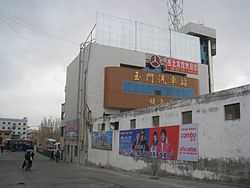Yumen City
| Yumen 玉门市 | |
|---|---|
| County-level city | |
 | |
.png) Location of Yumen City (pink) within Jiuquan City (yellow) and Gansu | |
| Coordinates: 39°50′N 97°34′E / 39.833°N 97.567°ECoordinates: 39°50′N 97°34′E / 39.833°N 97.567°E | |
| Country | People's Republic of China |
| Province | Gansu |
| Prefecture-level city | Jiuquan |
| Elevation | 1,507 m (4,944 ft) |
| Population (2002) | |
| • Total | 106,812 |
| Time zone | China Standard (UTC+8) |
| Postal code | 735200 |
| Area code(s) | 0937 |
Yumen (simplified Chinese: 玉门; traditional Chinese: 玉門; pinyin: Yùmén, literally, "Jade Gate,") is a city in western Gansu province, China. It is a county-level city with a population of 106,812 (2002 est.), and is part of Jiuquan "prefecture-level city" (a multi-county administrative unit). It is located on the Silk Road and is best known for its oil production.
The city's name is often confused with the Yumen Guan or Jade Gate which is the frontier-pass of ancient times, the entrance to the old Silk Roads, which was situated not far to the west of Dunhuang. Although both Yumen City and Yumen Gate are within Jiuquan, the latter is some 400 kilometres (250 mi) to the west from the former.
In 2014, areas of the city were sealed off after a resident died of the bubonic plague. Districts of the city which house up to 100,000 were turned into quarantine zones. The city allocated 1 million yuan to be used for emergency vaccinations.[1]
History
The site of Yumen was brought under Chinese control around the end of the 2nd century BCE. Yumen was known as 'Huiji' in the 5th century when the area was reclaimed by the Northern Wei Dynasty (386–534/535) and was soon after renamed back to Yumen in 581. Under the Tang Dynasty (618–907), Yumen's county seat was located at Chijinzhen which is east of the present Yumen City. The city was then under Tibetan control around 770 CE for some 70 years. After the Tang dynasty, Yumen became a part of the Western Xia (1038–1227). During the Ming dynasty (1368–1644), the area came under Tibetan control again and was only reestablished later on in the early Qing dynasty (1644–1912).[2]
Economy
The overland route to Western Asia from China flourished until the end of the Tang dynasty. Furthermore, due to increased use of sea transportation, Yumen became a backwater.
There were two catalysts for Yumen's rapid revival in the 1930s and 40s. The construction of a modern highway over the old caravan route from Yumen to Ürümqi (capital of the Uygur Autonomous Region of Xinjiang) and continuing on-wards to Kazakhstan. The railway of Yumen is the linking point of the railway line between Lanzhou (capital of Gansu) and Ürümqi.
After the discovery of oil in the Jiuquan basin, to the north of the Qilian Mountains the city's economy was given another major push. The first oil was drilled at Laojunmiao near Yumen in 1939 where an appreciable production was achieved in 1941. Only until 1949 did large-scale development begin where soon after prospecting after 1950 revealed much larger reserves than had been speculated. Yumen has its own refinery which is linked by pipeline to Lanzhou. Other than oil drilling and refining, Yumen also has thermal and wind power-generating facilities. Manufacturing includes machinery, building materials, chemical fertilizers and process agricultural products.[3]
Geography and climate
Yumen has a cold desert climate (Köppen BWk), with an annual total precipitation of 67 millimetres (2.64 in), the majority of which occurs in summer. Winters are long and cold, with a 24-hour average temperature of −9.8 °C (14.4 °F) in January, while summers are very warm, with a July average of 21.7 °C (71.1 °F); the annual mean is 7.13 °C (44.8 °F). The diurnal temperature variation reaches or exceeds 15 °C (27 °F) for much of the year. With monthly percent possible sunshine ranging from 67% in March to 80% in October, the city receives 3,214 hours of bright sunshine annually.
| Climate data for Yumen (1971−2000) | |||||||||||||
|---|---|---|---|---|---|---|---|---|---|---|---|---|---|
| Month | Jan | Feb | Mar | Apr | May | Jun | Jul | Aug | Sep | Oct | Nov | Dec | Year |
| Average high °C (°F) | −2.8 (27) |
1.7 (35.1) |
9.0 (48.2) |
17.5 (63.5) |
23.3 (73.9) |
26.9 (80.4) |
28.6 (83.5) |
27.9 (82.2) |
23.0 (73.4) |
15.2 (59.4) |
5.8 (42.4) |
−1.2 (29.8) |
14.58 (58.23) |
| Average low °C (°F) | −15.4 (4.3) |
−12.2 (10) |
−5.5 (22.1) |
1.8 (35.2) |
7.6 (45.7) |
11.9 (53.4) |
14.0 (57.2) |
12.8 (55) |
7.5 (45.5) |
0.5 (32.9) |
−6.7 (19.9) |
−13 (9) |
0.28 (32.5) |
| Average precipitation mm (inches) | 1.0 (0.039) |
1.3 (0.051) |
4.1 (0.161) |
4.3 (0.169) |
6.7 (0.264) |
12.9 (0.508) |
13.9 (0.547) |
12.5 (0.492) |
4.8 (0.189) |
2.1 (0.083) |
2.1 (0.083) |
1.1 (0.043) |
66.8 (2.629) |
| Avg. precipitation days (≥ 0.1 mm) | 1.8 | 1.4 | 2.3 | 2.3 | 2.4 | 5.0 | 5.8 | 4.6 | 1.9 | 1.1 | 1.9 | 2.3 | 32.8 |
| Average relative humidity (%) | 53 | 42 | 35 | 31 | 31 | 41 | 47 | 45 | 41 | 40 | 45 | 54 | 42.1 |
| Mean monthly sunshine hours | 221.7 | 214.1 | 248.5 | 274.8 | 314.5 | 312.0 | 311.0 | 306.7 | 292.4 | 276.2 | 229.7 | 212.0 | 3,213.6 |
| Percent possible sunshine | 75 | 72 | 67 | 69 | 71 | 70 | 68 | 72 | 78 | 80 | 77 | 73 | 72.7 |
| Source: China Meteorological Administration | |||||||||||||
References
| |||||||||||||||||||||||||||||||||||||||||||||||||||||||||||||||||||||||||||||||||||||||||